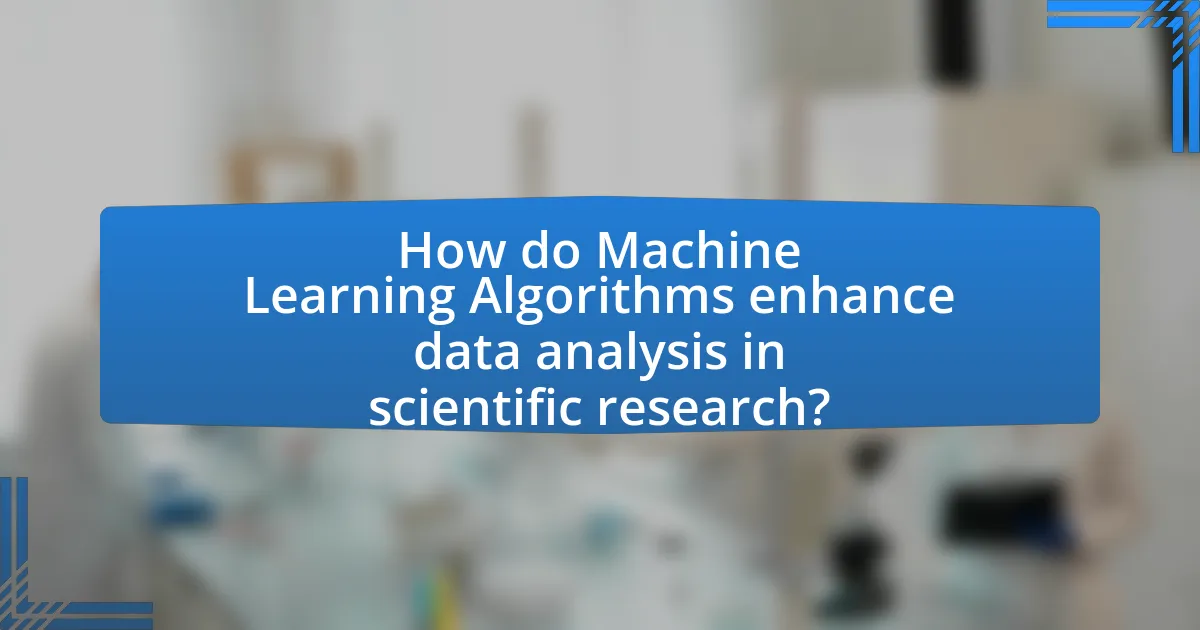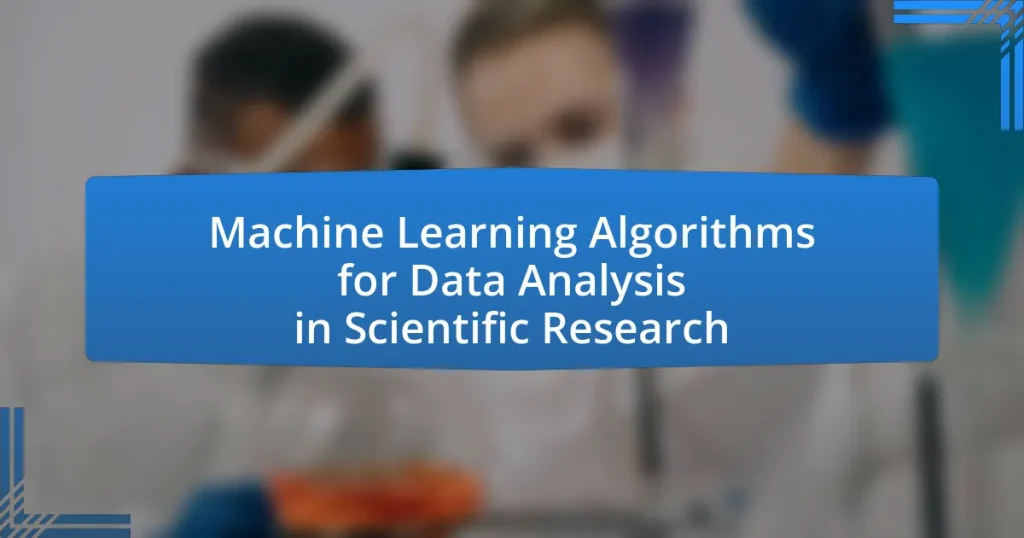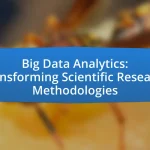Machine learning algorithms play a crucial role in data analysis within scientific research, encompassing techniques such as supervised learning, unsupervised learning, and reinforcement learning. These algorithms differ from traditional methods by their ability to learn from data and improve over time, enabling more complex pattern recognition and predictive capabilities. Key characteristics include adaptability, automation, and performance improvement, which enhance the accuracy and efficiency of research findings. The article explores the various types of machine learning algorithms, their applications in scientific disciplines, the challenges researchers face, and best practices for ensuring data quality and collaboration between data scientists and domain experts. Additionally, it highlights future trends and ethical considerations shaping the landscape of machine learning in research.

What are Machine Learning Algorithms for Data Analysis in Scientific Research?
Machine learning algorithms for data analysis in scientific research include supervised learning, unsupervised learning, and reinforcement learning techniques. Supervised learning algorithms, such as linear regression and support vector machines, are used to predict outcomes based on labeled training data. Unsupervised learning algorithms, like k-means clustering and hierarchical clustering, help identify patterns and groupings in unlabeled data. Reinforcement learning algorithms, such as Q-learning, optimize decision-making processes through trial and error. These algorithms have been validated through numerous studies, demonstrating their effectiveness in fields like genomics, climate modeling, and drug discovery, where they enhance data interpretation and predictive accuracy.
How do Machine Learning Algorithms differ from traditional data analysis methods?
Machine learning algorithms differ from traditional data analysis methods primarily in their ability to learn from data and improve over time without explicit programming. Traditional data analysis relies on predefined statistical models and assumptions, while machine learning utilizes algorithms that adapt based on the input data, allowing for more complex pattern recognition and predictive capabilities. For instance, machine learning can handle large datasets with high dimensionality and uncover hidden relationships that traditional methods may overlook, as evidenced by studies showing that machine learning models can outperform traditional regression techniques in tasks like image recognition and natural language processing.
What are the key characteristics of Machine Learning Algorithms?
Machine learning algorithms are characterized by their ability to learn from data, adapt to new inputs, and improve their performance over time without being explicitly programmed. These algorithms utilize statistical techniques to identify patterns and make predictions or decisions based on data. Key characteristics include:
-
Learning from Data: Machine learning algorithms can analyze large datasets to extract meaningful insights, enabling them to make predictions or classifications based on historical data.
-
Adaptability: These algorithms can adjust their models as new data becomes available, allowing them to remain relevant and accurate over time.
-
Automation: Machine learning automates the process of model building, reducing the need for manual intervention and enabling faster decision-making.
-
Generalization: Effective machine learning algorithms can generalize from training data to unseen data, ensuring that their predictions are applicable in real-world scenarios.
-
Performance Improvement: Many algorithms incorporate mechanisms for continuous improvement, such as reinforcement learning, where the model learns from the consequences of its actions.
These characteristics make machine learning algorithms powerful tools for data analysis in scientific research, facilitating the discovery of new knowledge and insights from complex datasets.
Why is Machine Learning increasingly used in scientific research?
Machine Learning is increasingly used in scientific research due to its ability to analyze vast amounts of data quickly and accurately. This capability allows researchers to uncover patterns and insights that would be difficult or impossible to detect using traditional statistical methods. For instance, a study published in Nature in 2020 demonstrated that machine learning algorithms could predict protein structures with remarkable accuracy, significantly advancing the field of structural biology. Additionally, machine learning enhances predictive modeling, enabling scientists to forecast outcomes in complex systems, such as climate change or disease spread, thereby improving decision-making processes in research.
What types of Machine Learning Algorithms are commonly used in scientific research?
Commonly used machine learning algorithms in scientific research include supervised learning algorithms such as linear regression, decision trees, and support vector machines, as well as unsupervised learning algorithms like k-means clustering and hierarchical clustering. These algorithms are employed for tasks such as predictive modeling, pattern recognition, and data classification. For instance, linear regression is frequently utilized in fields like epidemiology to model relationships between variables, while decision trees are often applied in bioinformatics for gene classification. The effectiveness of these algorithms is supported by numerous studies, including a 2020 review published in the journal “Nature” that highlights their application across various scientific disciplines, demonstrating their versatility and reliability in data analysis.
What are supervised learning algorithms and how are they applied?
Supervised learning algorithms are a category of machine learning techniques that utilize labeled datasets to train models for making predictions or classifications. These algorithms learn from input-output pairs, where the input features are associated with known output labels, allowing the model to generalize and make predictions on unseen data. Common applications include classification tasks, such as spam detection in emails, and regression tasks, such as predicting housing prices based on various features. The effectiveness of supervised learning is evidenced by its widespread use in industries like finance for credit scoring and healthcare for disease diagnosis, where accurate predictions are critical for decision-making.
What are unsupervised learning algorithms and their significance?
Unsupervised learning algorithms are a category of machine learning techniques that identify patterns and structures in data without labeled outcomes. These algorithms, such as k-means clustering and hierarchical clustering, analyze input data to group similar data points or reduce dimensionality, enabling insights into the underlying structure of the data. Their significance lies in their ability to uncover hidden patterns, facilitate exploratory data analysis, and enhance feature extraction, which is crucial in scientific research for discovering new relationships and insights from complex datasets. For instance, in genomics, unsupervised learning can identify gene expression patterns that may indicate disease states, thereby advancing medical research.
How do reinforcement learning algorithms contribute to data analysis?
Reinforcement learning algorithms contribute to data analysis by enabling systems to learn optimal decision-making strategies through interactions with their environment. These algorithms utilize feedback from actions taken to maximize cumulative rewards, which can be applied to various data analysis tasks such as optimizing resource allocation, enhancing predictive modeling, and improving data-driven decision-making processes. For instance, in a study by Mnih et al. (2015) titled “Human-level control through deep reinforcement learning,” the authors demonstrated how reinforcement learning could effectively analyze complex data environments, leading to superior performance in tasks like game playing and robotics. This ability to adapt and learn from data interactions makes reinforcement learning a powerful tool in the field of data analysis.
What challenges do researchers face when using Machine Learning Algorithms?
Researchers face several challenges when using Machine Learning algorithms, including data quality, algorithm selection, and interpretability. Data quality issues, such as missing values and noise, can significantly impact the performance of machine learning models, leading to inaccurate results. Additionally, selecting the appropriate algorithm for a specific problem is complex due to the vast array of available options, each with its strengths and weaknesses. Furthermore, interpretability remains a critical challenge; many machine learning models, particularly deep learning, operate as “black boxes,” making it difficult for researchers to understand how decisions are made. These challenges are well-documented in literature, such as the study by Lipton (2016) on interpretability in machine learning, which highlights the importance of understanding model behavior for trust and accountability in scientific research.
What are the common pitfalls in data preparation for Machine Learning?
Common pitfalls in data preparation for Machine Learning include inadequate data cleaning, failure to handle missing values, and improper feature selection. Inadequate data cleaning can lead to the inclusion of noise and irrelevant information, which negatively impacts model performance. Failure to handle missing values can result in biased predictions or loss of valuable data, as studies show that up to 30% of data can be missing in real-world datasets. Improper feature selection can cause overfitting or underfitting, as irrelevant features can dilute the model’s ability to learn from the data effectively. These pitfalls highlight the importance of thorough and systematic data preparation to ensure the success of Machine Learning applications.
How can overfitting and underfitting affect research outcomes?
Overfitting and underfitting can significantly distort research outcomes by compromising the accuracy and generalizability of machine learning models. Overfitting occurs when a model learns the training data too well, capturing noise and outliers, which leads to poor performance on unseen data. This can result in misleading conclusions, as the model may appear to perform well during training but fails to predict accurately in real-world scenarios. Conversely, underfitting happens when a model is too simplistic to capture the underlying patterns in the data, leading to high bias and inaccurate predictions. This can cause researchers to overlook important relationships within the data, ultimately affecting the validity of their findings. Studies have shown that models with high variance from overfitting can lead to a 20-30% decrease in predictive accuracy on test datasets, while underfitting can result in a similar range of performance loss due to inadequate model complexity.

How do Machine Learning Algorithms enhance data analysis in scientific research?
Machine learning algorithms enhance data analysis in scientific research by enabling the identification of complex patterns and relationships within large datasets. These algorithms, such as decision trees, neural networks, and support vector machines, can process vast amounts of data more efficiently than traditional statistical methods. For instance, a study published in Nature by Esteva et al. (2017) demonstrated that deep learning algorithms could accurately classify skin cancer from images, achieving performance comparable to dermatologists. This capability allows researchers to derive insights that may be overlooked using conventional analysis techniques, ultimately leading to more informed scientific conclusions and advancements.
What are the benefits of using Machine Learning Algorithms in data analysis?
Machine learning algorithms enhance data analysis by enabling the extraction of patterns and insights from large datasets efficiently. These algorithms can process vast amounts of data quickly, identifying trends that may not be apparent through traditional analysis methods. For instance, a study published in the journal “Nature” demonstrated that machine learning models could predict protein structures with high accuracy, significantly advancing biological research. Additionally, machine learning algorithms improve predictive analytics, allowing researchers to make data-driven decisions based on historical data trends. This capability is evidenced by a report from McKinsey, which found that organizations using machine learning for data analysis can increase their productivity by up to 40%.
How do these algorithms improve accuracy in research findings?
Machine learning algorithms improve accuracy in research findings by utilizing advanced statistical techniques to analyze large datasets, identifying patterns and correlations that traditional methods may overlook. These algorithms, such as decision trees and neural networks, can process vast amounts of data quickly and efficiently, leading to more reliable predictions and insights. For instance, a study published in the journal Nature demonstrated that machine learning models could predict disease outcomes with up to 90% accuracy, significantly outperforming conventional statistical methods. This enhanced capability allows researchers to draw more precise conclusions and make informed decisions based on data-driven evidence.
What role do Machine Learning Algorithms play in predictive modeling?
Machine learning algorithms are essential in predictive modeling as they enable the analysis of complex datasets to identify patterns and make forecasts. These algorithms, such as regression, decision trees, and neural networks, learn from historical data to predict future outcomes with high accuracy. For instance, a study published in the journal “Nature” demonstrated that machine learning models could predict protein structures with remarkable precision, showcasing their effectiveness in scientific research. This capability to process vast amounts of data and uncover hidden relationships makes machine learning algorithms a powerful tool in predictive modeling across various domains.
How do researchers implement Machine Learning Algorithms in their studies?
Researchers implement Machine Learning algorithms in their studies by first defining the problem and selecting appropriate algorithms based on the data characteristics and research objectives. They preprocess the data to ensure quality and relevance, which includes cleaning, normalizing, and transforming the data into suitable formats for analysis.
Next, they split the dataset into training and testing subsets to evaluate the performance of the algorithms. Researchers then train the selected algorithms on the training data, adjusting parameters to optimize performance. After training, they validate the model using the testing data to assess accuracy and generalizability.
Finally, researchers interpret the results, often using metrics such as accuracy, precision, recall, and F1 score to quantify the model’s effectiveness. This systematic approach is evident in studies like “Deep Learning for Image Classification: A Comprehensive Review” by LeCun et al., which illustrates the application of various algorithms in real-world scenarios, demonstrating the effectiveness of machine learning in scientific research.
What steps are involved in selecting the right algorithm for a specific research problem?
Selecting the right algorithm for a specific research problem involves several key steps. First, clearly define the research problem and objectives, as this will guide the selection process. Next, analyze the nature of the data, including its size, type, and quality, which influences algorithm suitability. Then, consider the algorithm’s performance metrics relevant to the problem, such as accuracy, precision, recall, or F1 score. After that, evaluate the complexity and interpretability of the algorithm, as simpler models may be preferred for clarity. Finally, conduct experiments with multiple algorithms and compare their results to identify the most effective one for the specific research context. This systematic approach ensures that the chosen algorithm aligns with the research goals and data characteristics.
How do researchers evaluate the performance of Machine Learning models?
Researchers evaluate the performance of Machine Learning models primarily through metrics such as accuracy, precision, recall, F1 score, and area under the ROC curve (AUC-ROC). These metrics provide quantitative measures of how well a model predicts outcomes based on a set of test data. For instance, accuracy measures the proportion of correct predictions, while precision and recall assess the model’s performance in identifying positive instances. The F1 score combines precision and recall into a single metric, offering a balance between the two. AUC-ROC evaluates the trade-off between true positive rates and false positive rates across different thresholds, providing insight into the model’s ability to distinguish between classes. These metrics are essential for validating model effectiveness and ensuring reliability in scientific research applications.

What future trends can we expect in Machine Learning for scientific research?
Future trends in Machine Learning for scientific research include increased automation of data analysis, enhanced interpretability of models, and the integration of multi-modal data sources. Automation will streamline workflows, allowing researchers to focus on hypothesis generation rather than data processing. Enhanced interpretability will address the “black box” nature of many algorithms, making it easier for scientists to understand and trust model outputs. The integration of multi-modal data sources, such as combining genomic, proteomic, and clinical data, will enable more comprehensive insights and foster interdisciplinary research. These trends are supported by advancements in algorithms and computational power, as well as a growing emphasis on reproducibility and transparency in scientific studies.
How is the integration of Machine Learning evolving in scientific disciplines?
The integration of Machine Learning in scientific disciplines is rapidly advancing, driven by its ability to analyze complex datasets and uncover patterns that traditional methods may overlook. For instance, in fields such as genomics, Machine Learning algorithms are being utilized to predict gene functions and interactions, significantly enhancing our understanding of biological processes. A study published in Nature Biotechnology by Esteva et al. (2019) demonstrated that deep learning models could accurately classify skin cancer from images, showcasing the potential of Machine Learning in medical diagnostics. Additionally, in climate science, Machine Learning is being employed to improve climate models and predict extreme weather events, as evidenced by research from the National Oceanic and Atmospheric Administration (NOAA) that highlights the effectiveness of these algorithms in processing vast amounts of climate data. This evolution reflects a broader trend of interdisciplinary collaboration, where Machine Learning techniques are increasingly applied across various scientific fields, enhancing research capabilities and outcomes.
What emerging technologies are influencing Machine Learning applications?
Emerging technologies influencing Machine Learning applications include quantum computing, edge computing, and advanced neural network architectures. Quantum computing enhances computational power, allowing for faster processing of complex algorithms, which can significantly improve machine learning model training times. Edge computing reduces latency by processing data closer to the source, enabling real-time analytics and decision-making in applications such as IoT devices. Advanced neural network architectures, such as transformers and generative adversarial networks (GANs), enable more sophisticated data representations and improved performance in tasks like natural language processing and image generation. These technologies collectively drive innovation and efficiency in machine learning applications across various domains.
How might ethical considerations shape the future of Machine Learning in research?
Ethical considerations will significantly shape the future of Machine Learning in research by guiding the development and application of algorithms to ensure fairness, transparency, and accountability. As researchers increasingly rely on Machine Learning for data analysis, ethical frameworks will dictate how data is collected, processed, and utilized, aiming to prevent biases that could lead to harmful outcomes. For instance, the implementation of guidelines like the Fairness, Accountability, and Transparency in Machine Learning (FAT/ML) principles emphasizes the need for equitable treatment across diverse populations, which is crucial in fields such as healthcare and criminal justice. Furthermore, regulatory bodies are likely to enforce compliance with ethical standards, influencing funding and publication opportunities for research that does not adhere to these guidelines. This shift towards ethical accountability is already evident in initiatives like the European Union’s General Data Protection Regulation (GDPR), which mandates data protection and privacy, thereby impacting how Machine Learning models are trained and deployed in research settings.
What best practices should researchers follow when using Machine Learning Algorithms?
Researchers should follow best practices such as data preprocessing, model selection, and validation techniques when using Machine Learning algorithms. Data preprocessing involves cleaning and transforming raw data to improve model performance, which is crucial as studies show that up to 80% of the time in data science projects is spent on data preparation. Model selection requires choosing the appropriate algorithm based on the problem type and data characteristics, ensuring that the chosen model aligns with the research objectives. Validation techniques, such as cross-validation, help assess model performance and prevent overfitting, which is essential for ensuring the reliability of results. Following these practices enhances the robustness and credibility of research findings in scientific studies utilizing Machine Learning.
How can researchers ensure data quality and integrity in their analyses?
Researchers can ensure data quality and integrity in their analyses by implementing rigorous data validation techniques and employing standardized protocols throughout the data collection and processing stages. For instance, utilizing automated data validation tools can help identify inconsistencies and errors in datasets, while adhering to established guidelines, such as those from the International Organization for Standardization (ISO), can enhance reliability. Additionally, conducting regular audits and peer reviews of the data and methodologies used can further safeguard against biases and inaccuracies, as evidenced by studies showing that systematic reviews improve data integrity in scientific research.
What strategies can enhance collaboration between data scientists and domain experts?
Enhancing collaboration between data scientists and domain experts can be achieved through regular interdisciplinary meetings, shared goals, and effective communication tools. Regular meetings facilitate the exchange of ideas and ensure alignment on project objectives, while shared goals foster a unified vision that drives collaboration. Effective communication tools, such as collaborative platforms and visualization software, help bridge the gap between technical and domain-specific language, making it easier for both parties to understand each other’s perspectives. Research indicates that teams with clear communication and defined roles are 25% more productive, highlighting the importance of these strategies in fostering effective collaboration.


